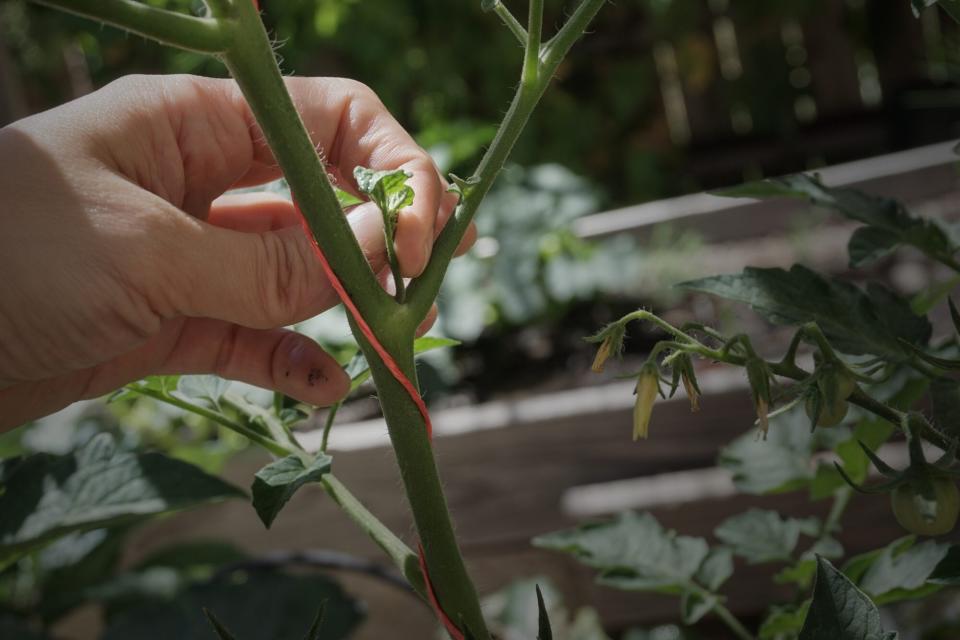How To Prune Tomato Plants
TABLE OF CONTENTS
On This Page
Determinate vs. Indeterminate Tomatoes
Pruning Means Improved Airflow
Pruning Means Bigger Fruit
How To Prune Tomatoes
If you fastidiously check on your tomato plants more than once a day, you probably already know that pruning can be an important part of your plant care routine. Pruning tomato plants is an optional, yet recommended, technique that some gardeners use to keep plants tidy, manipulate fruit size, and even hasten ripening. Before we talk about how to prune tomato plants, let's talk about why and which types of tomato plants you should prune.
Determinate vs. Indeterminate Tomatoes
When you purchase a tomato plant from a nursery, the container label should identify the plant as either determinate or indeterminate.
Determinate tomato varieties are often referred to as "bush" tomatoes because they do not continue extending in length throughout the season. Growing a determinate variety, such as Roma, is practical when you want a lot of tomatoes at one time for freezing or canning and are ideal for making tomato sauces. Determinate tomatoes do not need to be pruned; because they develop all of their fruit at one time, pruning may cause you to sacrifice tomatoes for no reason.
Indeterminate tomato varieties, such as Beefsteak and Brandywine, are vining plants that continue to extend in length and produce fruit throughout the growing season. Pruning indeterminates can help to keep the huge vines in control and encourage the plants to produce tomatoes large enough for your classic BLT sandwich or tomato pie, instead of lots of foliage and many smaller tomatoes. Many cherry tomato varieties are indeterminate as well, and proper pruning will guarantee clusters of tomatoes throughout the entire season.
Pruning Means Improved Airflow
Fewer leaves mean the plant is less dense, which allows for more air to flow among the stems. A well-pruned plant will also dry faster after a rain, so they are less susceptible to the diseases that develop from prolonged moisture, humid weather, and poor air circulation. Fungal, bacterial, and viral diseases can all infect tomato plants. Among the most common, and perhaps the most detrimental, is late blight, caused by the Phytophthora infestans fungus. It can kill the entire plant and is highly contagious, spreading by releasing spores into the wind. Other diseases to read up on and look out for include early blight, southern blight, fusarium wilt, buckeye rot, blossom end rot, septoria leaf spot, gray wall, anthracnose, verticillium wilt, and bacterial speck. Fewer leaves also make it easier to spot insect pests that like to hide in thick canopies of leaves. Common enemies of tomato plants are aphids, hornworms, thrips, whiteflies, tomato psyllid, fruitworms, and flea beetles.
Pruning Means Bigger Fruit
Pruning at the right time directs the plant's energy toward creating and ripening fruit instead of making more leaves. Overall, you will probably have less fruit on a pruned plant, but the fruit will ultimately grow to be bigger. And, since pruned plants can be put a bit closer together in the ground because the growth is so vertical, you can have more overall plants in your home garden. When a plant has fewer leaves and less fruit to take care of, that fruit ripens faster. This can help in short-season climates, where getting a tomato harvest is often a race against time, thanks to early fall frosts.

Melinda Podor/Getty Images
How To Prune Tomatoes
Pruning is really a simple process. Look for the tomato "suckers," which are the side shoots that grow in the "V" space between the main stem and the branches on your plant. If left alone, these suckers will eventually grow into full-sized branches—adding lots of foliage and, eventually, a few fruits. This will also result in a tomato plant that quickly outgrows its space in the garden.
To prune, simply remove the suckers. If under two inches long, you can pinch the sucker off with your fingers, but use a pair of clean gardening pruners for larger ones. Always disinfect your pruners with bleach as you move from one plant to another to prevent the spread of disease. Keep an eye on your tomato plants so you can remove suckers as they emerge. Removing large amounts of foliage at one time can be stressful for the plant.
Stake up or remove any branches that are low-hanging or touching the ground; foliage that is touching the ground can be susceptible to many of the aforementioned bacteria, fungi, and viral infections that can spread through the rest of the plant.

